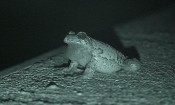FRAMIMGHAM, MA – From the first warm nights in spring, when the air temperature is above 60 degrees, strange sounds can be heard coming from the wet woodlands around Framingham. The sounds can last through most of the summer.
Some people think birds or strange insects are making the sounds, but it’s actually a tree dwelling frog; Hyla versicolor — more commonly known as the Gray Treefrog.
The one and half to two inch mottled grey, black and green frogs live in wet woody areas and spend the cooler months in hollowed out trees, In the winter the frogs hybernate underground, beneath insulating layers of fallen debris and leaf litter.
In breeding season, (March to August), the frogs gather near the water’s edge and the mating calls begin, (and can last until ’til nearly midnight).
As the “versicolor” portion of their scientific name implies, the Gray Treefrog can change color from almost stark white to a dark mottled greyish green.
The skin on the back of the Gray Treefrog is bumpy, (again, part of their camouflage — the texture along with the blended color make then nearly invisible as they cling to the bark or moss of a tree or log). The frog’s underside is smooth with bright yellow skin on the inside of their hind legs. It’s fingers and toes have sticky pads which make them apt climbers.
While the sounds may be annoying, it may be of some comfort to realize that frogs are one of our best early warnings of environmental danger. Acting like a “canary in a coal mine“, many species of frogs around the world lose their lives because of man. Frogs in the wild suffer from air, water and soil pollution, man made changes in temperature and other ways we alter the environment.
A healthy frog population is a good indication the environment in the area they live is healthy too. So, don’t worry when you hear them at night — instead, worry that some day you might not.
###
